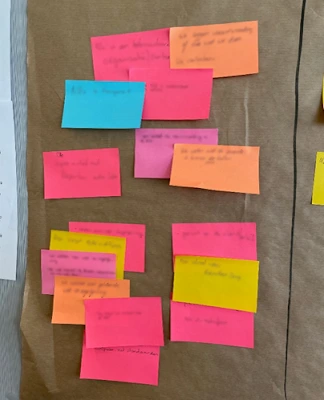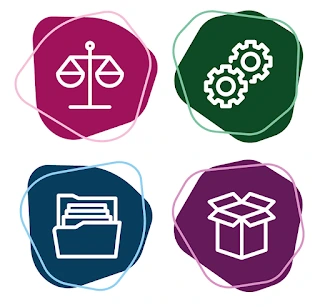Some time ago, I’ve had the pleasure of sitting down with a group of knowledgeable people for the purpose of establishing basic principles for an organisation.
Of course, the Post-Its (sticky notes) were the first thing people reached for when I suggested expressing our thoughts regarding what was really important to the organisation. Sheets of brown paper were pulled out and the brightly coloured Post-Its were spread out in piles on the desk.
Over the years, I have somehow developed an aversion to the use of Post-Its. No idea where exactly it went wrong, but somewhere in my career the aversion to the use of those (then) yellow (and now multi-coloured) non-sticky and far too small notes started and never went away.
Multi(-coloured) layers

We started our session by attaching the brown paper (who on earth came up with the idea of using brown paper for this?) to the wall. The organisation was then divided into five layers, entirely according to Nictiz’s interoperability model1. This interoperability model is characterised by dividing an organisation not into the usual three layers of architecture (business, information/application and technology), but into five layers. The business layer is divided into two layers (organisational and process-oriented) and the information/application layer is split into business and information objects on the one hand and a separate application layer on the other hand. Five layers in total.
For each layer, I and my teammates tried to identify the most essential focus areas and activities that the organisation was working on, or should be working on, based on the company’s strategy. Of all these activities, we then sought to identify their essence. To illustrate, many of the pink, blue, yellow and orange stickers within the organisational layer referred to the application of all kinds of laws and regulations. Put together, it resulted in the creation of the first basic principle Comply with laws and regulations.
Summing it all up
Each layer we had drawn on the brown paper was eventually plastered with the sticky notes and the common denominator of each layer was determined. This ultimately led to four basic principles. Now, I hear you thinking, four basic principles while five layers were defined? Indeed, four basic principles, because the application and technology layers together lead to the principle Standard products and services.
After agreement was reached on the four basic principles, the long road of obtaining a determination by the Board of Directors began. Within the organisation, such adoption is essential, because only then has it gained enough body to be actually adopted. Once approved by the Board, it would be possible to instruct management teams to monitor compliance with the basic principles.
The importance of sticking to principles should not be in question. In an earlier blog, I said that principles are the ingredient for success. I still stand by that statement.
Painting a picture
Speaking the same language as the organisation really helps to get the message across. This is why I chose to have the explanatory texts belonging to the principles checked by the Communications department. They know much better how to edit texts so that they are expressed in the language of the organisation. After a few moments of consultation, the texts were ready for use and could be passed on to the graphic design department. Since a picture often says more than a thousand words, visualising this kind of framework plays a big role in its acceptance.

What I really wanted to achieve was the creation of an icon per principle. In other words, a symbol that represented the essence of each principle.
Comply with laws and regulations was captured in an icon indicating a scale. Everyone will instantly associate this with laws.
A similar result was achieved with Standard products and services by capturing it in an unfolded cardboard box. Simple, but powerful.
Talking the talk
The basic principles were expressed as briefly as possible. No whole sentences, but short and concise and really focused on the essence of the principles. What also helped a lot was translating them into the language the organisation speaks. So not Process-oriented collaboration, but Uniform way of working. Process-oriented collaboration is what can be achieved by working in a unified way. The devil sometimes really is in the detail.
Common mistakes
One of the most common mistakes made when drafting principles is thinking that as soon as a sentence is in the imperative, it is automatically a principle. I often see phrases like Cloud first2 or Information has an owner. These phrases are not principles. They are, at best, requirements or even standards. And standards are a derivative of requirements, where requirements, in turn, are derived from principles.
The whole idea behind principles is that they are close to the business goals to be achieved. They can then be further specified and detailed using requirements, supplemented by standards if need be.
So no, writing a sentence in imperative does not make it a principle.
The road ahead is sticky
Our four basic principles are expected to be established soon and that will mark the starting point for the organisation to implement its activities in a more structured and determined manner.
What started months ago with the application of brightly coloured sticky notes on ugly brown paper has ended in a graphically fantastic visual of four basic principles that will help the organisation get and keep a grip on its information management.
All in all, that’s actually pretty good for such a small piece of brightly coloured non-adhesive paper…
1 Nictiz is the Dutch independent national competence centre for electronic exchange of health and care information.
2 Cloud first might actually be a principle, should the organisation provide IT-services to its customers.







Leave a Reply